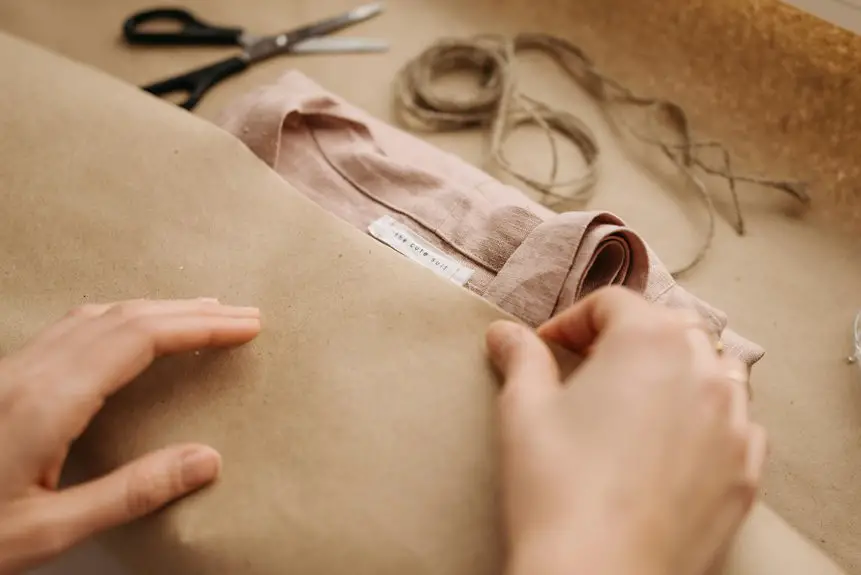To wash polycotton, use a mild liquid detergent and cold or warm water on a gentle cycle to protect your fabric’s blend of polyester and cotton. Avoid bleach and hot water to prevent damage and shrinkage. Treat stains carefully by blotting and pre-treating cautiously. Dry on low heat or air dry to keep your clothes looking fresh, then iron on low heat if needed. Follow these basics, and you’ll find even more tips to keep your polycotton lasting longer and looking great.
Table of Contents
Key Takeaways
- Use mild liquid detergents and avoid bleach to protect polycotton fibers and maintain fabric quality.
- Wash polycotton on gentle cycle with cold or warm water to prevent shrinking and fiber damage.
- Blot stains gently and pre-treat cautiously, testing on hidden areas to avoid fabric damage.
- Dry polycotton on low or medium heat or air dry to minimize shrinking and preserve fabric life.
- Iron on low to medium heat using a pressing cloth, and store folded away from direct sunlight.
Understanding Polycotton Fabric Composition
Polycotton combines the best of two fabrics: polyester and cotton. When you choose polycotton, you get the softness and breathability of cotton with the strength and wrinkle resistance of polyester.
This blend typically contains about 65% polyester and 35% cotton, but ratios can vary. Understanding this mix helps you care for your fabric properly. The polyester fibers add durability and reduce shrinkage, while the cotton fibers allow for comfort and moisture absorption.
This combination means your polycotton clothes dry faster and resist wrinkles better than pure cotton. Knowing how these fibers work together lets you avoid mistakes that could damage the fabric.
Selecting the Right Detergent for Polycotton
When you choose a detergent, make sure it’s gentle enough to protect both the cotton and polyester fibers in your fabric. Avoid harsh chemicals or bleach, which can weaken the blend. Opt for mild, liquid detergents designed for delicate fabrics or those labeled “color-safe” to maintain vibrancy. Detergents with enzymes or brighteners may harm the polyester component, so steer clear.
| Detergent Type | Suitable for Polycotton | Avoid if Sensitive to |
|---|---|---|
| Mild Liquid | Yes | Harsh chemicals |
| Powdered | Use cautiously | Residue buildup |
| Enzyme-based | No | Fiber damage |
Picking the right detergent keeps your polycotton soft, strong, and looking fresh longer.
Ideal Washing Machine Settings for Polycotton
Although washing machines offer many settings, you’ll want to choose those that protect the delicate balance of cotton and polyester fibers in polycotton.
Start by selecting a gentle or delicate cycle to minimize agitation, preventing fiber damage. Set the water temperature to cold or warm, avoiding hot water that can cause shrinkage or weaken the fabric.
Use a slow to medium spin speed to reduce stress on the fibers and lessen wrinkles. Avoid heavy-duty or permanent press cycles, which are too harsh.
If your machine has an option for extra rinse, use it to remove detergent residues that can dull polycotton.
Hand Washing Techniques for Delicate Polycotton
If you prefer a gentler approach than machine washing, hand washing offers greater control over how your delicate polycotton items are treated. Start by filling a basin with lukewarm water and add a mild detergent. Submerge your polycotton garment and gently agitate it with your hands to loosen dirt. Avoid wringing or scrubbing to prevent damage. After soaking for about 10 minutes, rinse thoroughly with cool water until all soap is gone. Press out excess water gently without twisting.
| Step | Action | Tip |
|---|---|---|
| Fill basin | Lukewarm water + detergent | Use mild detergent |
| Soak & agitate | 10 minutes | Gentle hand movements |
| Rinse | Cool water | Remove all soap |
| Dry | Press water out gently | Avoid wringing or twisting |
Effective Stain Removal on Polycotton Fabrics
When you spot a stain on your polycotton fabric, identifying its type is key to effective removal.
You’ll want to use the right pre-treatment techniques and choose safe cleaning agents to protect the material.
Let’s explore how to tackle common stains without damaging your clothes.
Common Stain Types
Anyone who deals with polycotton knows that stains can be tricky to remove, but understanding common stain types makes the process much easier. Different stains require different approaches, so recognizing what you’re up against helps you choose the right cleaning method.
| Stain Type | Common Sources |
|---|---|
| Protein-based | Blood, sweat, dairy |
| Oil-based | Grease, makeup |
| Dye-based | Coffee, wine, ink |
| Tannin-based | Tea, fruit juices |
| Combination | Sauce, chocolate |
Knowing the stain type speeds up your response and prevents damage. For example, protein stains shouldn’t be treated with hot water, while oil stains need a solvent-based cleaner. This knowledge is the first step in keeping your polycotton fresh and stain-free.
Pre-Treatment Techniques
Recognizing the type of stain on your polycotton fabric sets you up for successful removal, but taking action with the right pre-treatment techniques makes all the difference.
Start by gently blotting the stain with a clean cloth to lift excess residue—never rub, as that can push the stain deeper. For oily stains, sprinkle some baking soda or cornstarch to absorb the grease before brushing it off.
If the stain is protein-based, like blood or sweat, soak the area in cold water to prevent setting. Always test any pre-treatment on a hidden spot first to avoid damage.
Apply your chosen method promptly, as fresh stains respond best. These steps prepare your polycotton for washing, boosting your chances of complete stain removal without harming the fabric.
Safe Cleaning Agents
Although polycotton blends are durable, you’ll want to choose cleaning agents that effectively tackle stains without damaging the fabric.
Opt for mild detergents designed for delicate or synthetic fabrics. Avoid bleach and harsh chemicals, as they can weaken fibers and cause discoloration.
For stubborn stains, try a gentle stain remover or a mixture of water and white vinegar. Test any cleaning agent on a small, hidden area first to verify it won’t affect the color or texture.
When removing grease or oil, use a small amount of dish soap directly on the stain before washing.
Best Practices for Drying Polycotton Clothes
When drying polycotton clothes, you should opt for low heat settings to prevent shrinking and preserve fabric quality. High temperatures can damage the blend, so keeping it gentle is key.
Follow these best practices to maintain your polycotton items in great shape:
- Use a low or medium heat setting on your dryer.
- Remove clothes promptly to avoid wrinkles and static buildup.
- If possible, air dry by laying flat or hanging to extend fabric life.
- Avoid overloading the dryer to guarantee even drying and reduce wear.
Tips for Ironing and Storing Polycotton Items
Since polycotton blends can be sensitive to high heat, you’ll want to iron them on a low to medium setting to avoid damaging the fabric. Use a pressing cloth to protect the surface and prevent shiny marks. When storing, fold polycotton items neatly to minimize wrinkles, and keep them in a cool, dry place away from direct sunlight to preserve color and fabric strength.
| Ironing Tips | Storage Tips |
|---|---|
| Use low to medium heat | Fold clothes to avoid creases |
| Iron inside out if possible | Store in breathable containers |
| Avoid steam on delicate areas | Keep away from direct sunlight |
| Use a pressing cloth | guarantee items are completely dry |
Following these tips will keep your polycotton items looking fresh and last longer.
Frequently Asked Questions
Can Polycotton Cause Allergies or Skin Irritation?
You might experience allergies or skin irritation from polycotton if you’re sensitive to synthetic fibers or chemicals used in production. Always check labels and wash new items before wearing to reduce potential reactions and protect your skin.
Is Polycotton Fabric Environmentally Friendly?
Polycotton isn’t the most eco-friendly since it blends synthetic and natural fibers, making recycling tricky. You’ll want to choose organic or recycled options when possible to reduce environmental impact and support sustainable practices.
How Long Does Polycotton Typically Last With Proper Care?
Think of polycotton like a well-tended garden; with proper care, it can thrive for 5-10 years. You’ll notice its blend stays strong and vibrant, resisting wear just like healthy, nurtured plants flourish season after season.
Can Polycotton Be Safely Dry Cleaned?
You can safely dry clean polycotton, but it’s usually unnecessary. If you choose dry cleaning, make sure to inform the cleaner about the fabric blend to avoid harsh chemicals that might damage the fibers or affect the fabric’s feel.
Does Polycotton Shrink After Multiple Washes?
Polycotton promises minimal shrinkage, especially if you wash with warm water and gentle cycles. You’ll likely avoid alarming alterations after multiple washes, but always air dry to maintain fabric’s fit and freshness for longer.
- What Is Percale Cotton? A Refresher on the Basics - July 14, 2025
- What Fabric Is Percale? A Simple Explanation for Shoppers - July 14, 2025
- What Material Is Percale? Unpacking the Weave and Fiber - July 14, 2025







